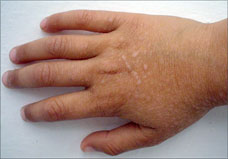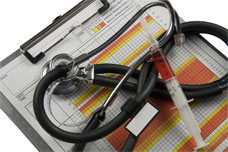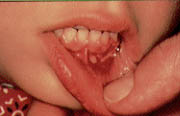|
What is celiac disease?
Celiac disease is a digestive
disease that damages the small intestine and interferes with
absorption of nutrients from food. People who have celiac disease
cannot tolerate gluten, a protein in wheat, rye, and barley.
Gluten is found mainly in foods but may also be found in everyday
products such as medicines, vitamins, and lip balms.

The small intestine is
shaded above.
When people with celiac disease
eat foods or use products containing gluten, their immune system
responds by damaging or destroying villi—the tiny, fingerlike
protrusions lining the small intestine. Villi normally allow
nutrients from food to be absorbed through the walls of the small
intestine into the bloodstream. Without healthy villi, a person
becomes malnourished, no matter how much food one eats.

Villi on the lining of
the small intestine help absorb nutrients.
Celiac disease is both a disease
of malabsorption—meaning nutrients are not absorbed properly—and
an abnormal immune reaction to gluten. Celiac disease is also
known as celiac sprue, nontropical sprue, and gluten-sensitive
enteropathy. Celiac disease is genetic, meaning it runs in
families. Sometimes the disease is triggered—or becomes active for
the first time—after surgery, pregnancy, childbirth, viral
infection, or severe emotional stress.
What are the symptoms of celiac disease?
Symptoms of celiac disease vary
from person to person. Symptoms may occur in the digestive system
or in other parts of the body. Digestive symptoms are more common
in infants and young children and may include :
-
abdominal bloating and pain
-
chronic diarrhea
-
vomiting
-
constipation
-
pale, foul-smelling, or fatty
stool
-
weight loss
Irritability is another common
symptom in children. Malabsorption of nutrients during the years
when nutrition is critical to a child’s normal growth and
development can result in other problems such as failure to thrive
in infants, delayed growth and short stature, delayed puberty, and
dental enamel defects of the permanent teeth.
Adults are less likely to have
digestive symptoms and may instead have one or more of the
following:
-
unexplained iron-deficiency
anemia
-
fatigue
-
bone or joint pain
-
arthritis
-
bone loss or osteoporosis
-
depression or anxiety
-
tingling numbness in the hands
and feet
-
seizures
-
missed menstrual periods
-
infertility or recurrent
miscarriage
-
canker sores inside the mouth
-
an itchy skin rash called
dermatitis herpetiformis
People with celiac disease may
have no symptoms but can still develop complications of the
disease over time. Long-term complications include
malnutrition—which can lead to anemia, osteoporosis, and
miscarriage, among other problems—liver diseases, and cancers of
the intestine.
Why
are celiac disease symptoms so varied?
Researchers are studying the
reasons celiac disease affects people differently. The length of
time a person was breastfed, the age a person started eating
gluten-containing foods, and the amount of gluten-containing foods
one eats are three factors thought to play a role in when and how
celiac disease appears. Some studies have shown, for example, that
the longer a person was breastfed, the later the symptoms of
celiac disease appear.
Symptoms also vary depending on
a person’s age and the degree of damage to the small intestine.
Many adults have the disease for a decade or more before they are
diagnosed. The longer a person goes undiagnosed and untreated, the
greater the chance of developing long-term complications.
What other health problems do people with
celiac disease have?
People with celiac disease tend to
have other diseases in which the immune system attacks the body’s
healthy cells and tissues. The connection between celiac disease
and these diseases may be genetic. They include :
-
type 1 diabetes
-
autoimmune thyroid disease
-
autoimmune liver disease
-
rheumatoid arthritis
-
Addison’s disease, a condition
in which the glands that produce critical hormones are damaged
-
Sjögren’s syndrome, a
condition in which the glands that produce tears and saliva are
destroyed
How common is celiac disease?
Celiac disease affects people in
all parts of the world. Originally thought to be a rare childhood
syndrome, celiac disease is now known to be a common genetic
disorder. More than 2 million people in the United States have the
disease, or about 1 in 133 people. Among people who have a
first-degree relative—a parent, sibling, or child—diagnosed with
celiac disease, as many as 1 in 22 people may have the disease.
Celiac disease is also more
common among people with other genetic disorders including Down
syndrome and Turner syndrome, a condition that affects girls’
development.
How is celiac disease diagnosed?
Recognizing celiac disease can be
difficult because some of its symptoms are similar to those of
other diseases. Celiac disease can be confused with irritable
bowel syndrome, iron-deficiency anemia caused by menstrual blood
loss, inflammatory bowel disease, diverticulitis, intestinal
infections, and chronic fatigue syndrome. As a result, celiac
disease has long been underdiagnosed or misdiagnosed. As doctors
become more aware of the many varied symptoms of the disease and
reliable blood tests become more available, diagnosis rates are
increasing.
Blood
Tests
People with celiac disease have
higher than normal levels of certain autoantibodies—proteins that
react against the body’s own cells or tissues—in their blood. To
diagnose celiac disease, doctors will test blood for high levels
of anti-tissue transglutaminase antibodies (tTGA) or anti-endomysium
antibodies (EMA). If test results are negative but celiac disease
is still suspected, additional blood tests may be needed.
Before being tested, one should
continue to eat a diet that includes foods with gluten, such as
breads and pastas. If a person stops eating foods with gluten
before being tested, the results may be negative for celiac
disease even if the disease is present.
Intestinal Biopsy
If blood tests and symptoms suggest
celiac disease, a biopsy of the small intestine is performed to
confirm the diagnosis. During the biopsy, the doctor removes tiny
pieces of tissue from the small intestine to check for damage to
the villi. To obtain the tissue sample, the doctor eases a long,
thin tube called an endoscope through the patient’s mouth and
stomach into the small intestine. The doctor then takes the
samples using instruments passed through the endoscope.
Dermatitis Herpetiformis
Dermatitis herpetiformis (DH) is an
intensely itchy, blistering skin rash that affects 15 to 25
percent of people with celiac disease. The rash usually occurs on
the elbows, knees, and buttocks. Most people with DH have no
digestive symptoms of celiac disease.
DH is diagnosed through blood
tests and a skin biopsy. If the antibody tests are positive and
the skin biopsy has the typical findings of DH, patients do not
need to have an intestinal biopsy. Both the skin disease and the
intestinal disease respond to a gluten-free diet and recur if
gluten is added back into the diet. The rash symptoms can be
controlled with antibiotics such as dapsone. Because dapsone does
not treat the intestinal condition, people with DH must maintain a
gluten-free diet.
Screening
Screening for celiac disease means
testing for the presence of autoantibodies in the blood in people
without symptoms. Americans are not routinely screened for celiac
disease. However, because celiac disease is hereditary, family
members of a person with the disease may wish to be tested. Four
to 12 percent of an affected person’s first-degree relatives will
also have the disease.
How is celiac disease treated?
The only treatment for celiac
disease is a gluten-free diet. Doctors may ask a newly diagnosed
person to work with a dietitian on a gluten-free diet plan. A
dietitian is a health care professional who specializes in food
and nutrition. Someone with celiac disease can learn from a
dietitian how to read ingredient lists and identify foods that
contain gluten in order to make informed decisions at the grocery
store and when eating out.
For most people, following this
diet will stop symptoms, heal existing intestinal damage, and
prevent further damage. Improvement begins within days of starting
the diet. The small intestine usually heals in 3 to 6 months in
children but may take several years in adults. A healed intestine
means a person now has villi that can absorb nutrients from food
into the bloodstream.
To stay well, people with celiac
disease must avoid gluten for the rest of their lives. Eating even
a small amount of gluten can damage the small intestine. The
damage will occur in anyone with the disease, including people
without noticeable symptoms. Depending on a person’s age at
diagnosis, some problems will not improve, such as short stature
and dental enamel defects.
Some people with celiac disease
show no improvement on the gluten-free diet. The most common
reason for poor response to the diet is that small amounts of
gluten are still being consumed. Hidden sources of gluten include
additives such as modified food starch, preservatives, and
stabilizers made with wheat. And because many corn and rice
products are produced in factories that also manufacture wheat
products, they can be contaminated with wheat gluten.
Rarely, the intestinal injury
will continue despite a strictly gluten-free diet. People with
this condition, known as refractory celiac disease, have severely
damaged intestines that cannot heal. Because their intestines are
not absorbing enough nutrients, they may need to receive nutrients
directly into their bloodstream through a vein, or intravenously.
Researchers are evaluating drug treatments for refractory celiac
disease.
|









